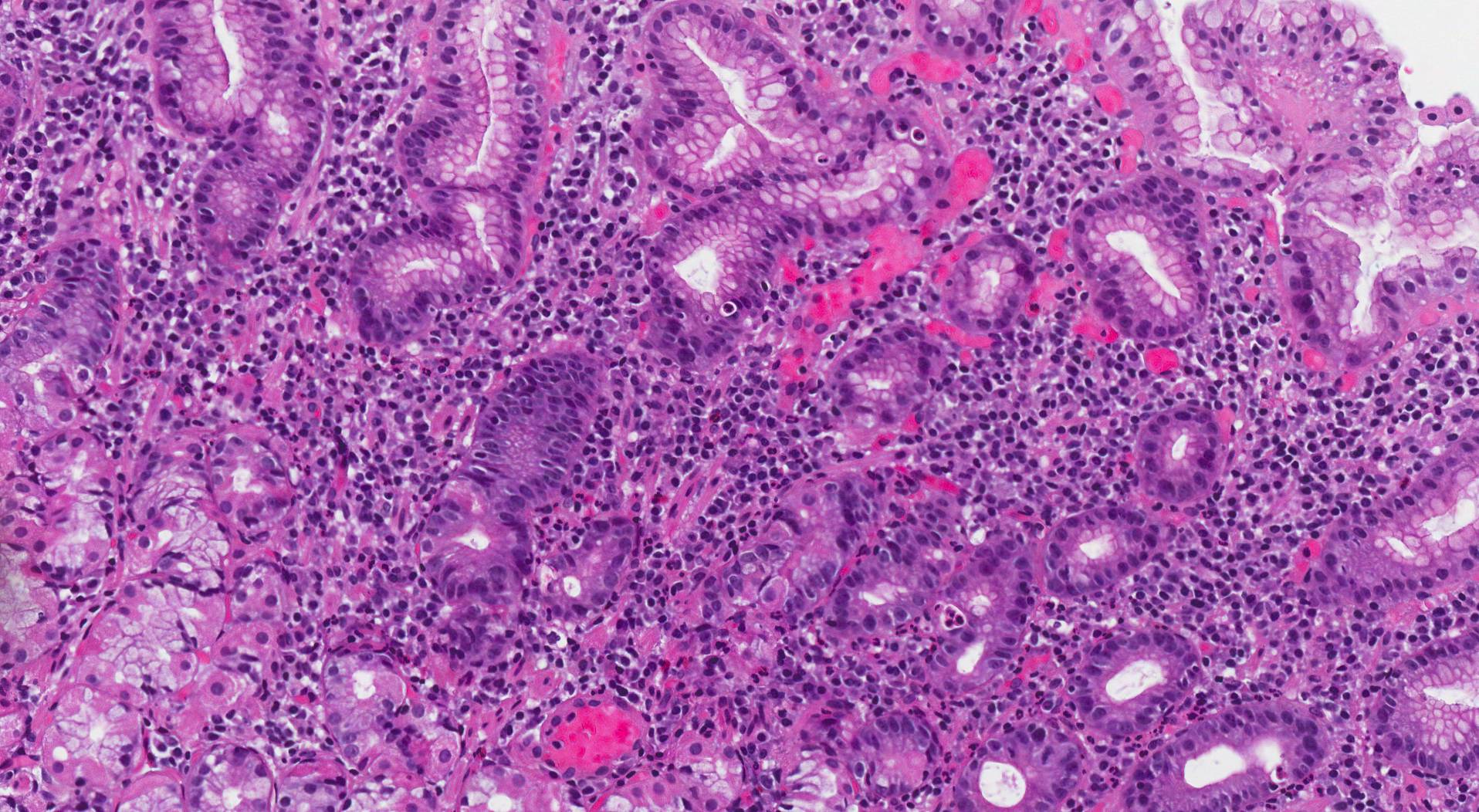by Jason Wasserman MD PhD FRCPC
March 7, 2023
What is chronic active gastritis?
Chronic active gastritis is a condition where inflammation damages the tissue that covers the inside of the stomach. The damage prevents the stomach from functioning normally. The term “chronic” means that the inflammation has been present in the stomach for a long time. The term “active” means that immune cells called neutrophils are causing ongoing damage to the stomach.
What are the symptoms of chronic active gastritis?
The most common symptoms of chronic active gastritis are abdominal pain (aching or burning) that is worse when the stomach is empty, nausea, bloating, and loss of appetite.
What causes chronic active gastritis?
The most common cause of chronic active gastritis is an infection of the stomach with a bacteria called Helicobacter pylori. Pathologists often describe this condition as Helicobacter gastritis. Infection is more common in rural areas and in developing parts of the world. Chronic active gastritis can also be seen in people who have previously been treated for Helicobacter pylori. Chronic active gastritis may persist for months or even years after successful treatment.
Other causes of chronic active gastritis include:
- Non-steroidal anti-inflammatory drugs (NSAIDs) such as Aspirin and Advil.
- Excessive alcohol intake.
- Bile reflux.
- Autoimmune diseases.
How is the diagnosis of chronic active gastritis made?
The diagnosis of chronic active gastritis is usually made after a small sample of tissue is removed in a procedure called a biopsy. The tissue is then examined under a microscope by a pathologist. Your pathologist may order additional tests such as immunohistochemistry or special stains to look for Helicobacter pylori micro-organisms in the tissue sample.
What does chronic active gastritis look like under the microscope?
When examined under the microscope, pathologists look for two features to make the diagnosis of chronic active gastritis. The first is chronic inflammation. This means seeing specialized immune cells such as plasma cells and lymphocytes in a thin layer of connective tissue called the lamina propria. The second is active or acute inflammation. This means seeing specialized immune cells called neutrophils in either the lamina propria or the epithelium. In contrast, inactive gastritis means that no neutrophils were seen in the mucosa.

Some pathologists further divide active gastritis into mild, moderate, or severe based on the type of damage being caused by the neutrophils.
- Mildly active: Neutrophils are seen in the lamina propria and some may be seen in between epithelial cells. Pathologists sometimes use the term cryptitis to describe this type of activity.
- Moderately active: As with mild activity, neutrophils are seen in the lamina propria. In addition, groups of neutrophils are usually seen inside the glands. Pathologists use the term crypt abscess to describe this type of activity.
- Severely active: At this level of activity the epithelium that normally covers the inside surface of the stomach has been lost. Pathologists use the term ulcer or ulceration to describe this change. An ulcer in the stomach means that the tissue that is normally found under the epithelium is exposed to the inside environment of the stomach. If not treated, an ulcer can lead to bleeding in the stomach.
What does intestinal metaplasia mean and why is it important?
Chronic active gastritis damages the epithelium that covers the inside of the stomach. If the damage continues for many years, the epithelium is replaced by cells normally found in a part of the gastrointestinal tract called the small intestine. This process is called intestinal metaplasia. If intestinal metaplasia is in the tissue sample, it will be described in your report.
Intestinal metaplasia is important because it increases the risk of developing a type of stomach cancer called adenocarcinoma over time. The risk is higher when another type of change called dysplasia is also seen.
What does dysplasia mean and why is it important?
Dysplasia is a word pathologists use to describe an abnormal pattern of growth. Like intestinal metaplasia, dysplasia can develop in patients who have had chronic active gastritis for many years. Most patients with chronic active gastritis will not have dysplasia but when seen it will be described in your report. Pathologists divide dysplasia into low grade dysplasia and high grade dysplasia based on how abnormal the tissue looks when examined under a microscope.
Dysplasia is important because it increases the risk of developing a type of stomach cancer called adenocarcinoma over time. The risk is higher when high grade dysplasia is seen.
What is the treatment for chronic active gastritis?
Chronic active gastritis caused by Helicobacter pylori infection should be treated with antibiotics. If left untreated, Helicobacter infection can cause stomach ulcers. Untreated Helicobacter infection also increases the risk of developing cancer in the stomach. Patients should also talk to their doctor about any medications they may be taking which can cause chronic active gastritis.


